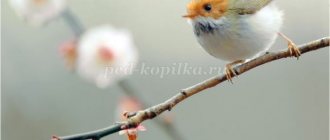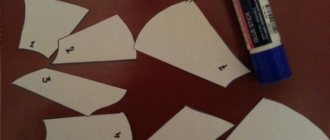Summary of OOD in kindergarten on environmental development. Senior group
Abstract of the OOD on environmental development “Take care of nature” in the senior group
Description of the material: The material can be used when conducting open classes on ecology within the framework of “Take care of nature” projects with children 5-6 years of age. The lesson is held in a playful way, very exciting and interesting. It will be useful for kindergarten teachers. Goal: To form in children a responsible and kind attitude towards their native nature. Objectives: Educational:
To consolidate children’s understanding of the forest as a habitat for wild animals.
To consolidate the concept of “wild animals”, the ability to distinguish and name their homes. Introduce the concept of a nature reserve and the protected animals of the Voronezh Nature Reserve. Developmental:
Develop horizons, coherent speech, thinking, memory.
Educational:
To cultivate love and respect for nature, the desire to protect it and provide all possible assistance to it.
Preliminary work: Examination of paintings and illustrations about the forest and wild animals. Reading works about life in the forest. Making riddles about wild animals. Equipment: multimedia installation, pictures of wild animals, video film “Nature’s Smile”, children’s educational cartoon “Tralik and Roller”, pictures “Rules of Conduct in the Forest”, letter from the residents of the reserve, puzzles “Wild Animals”, pine cones, nuts, carrots , cabbage,
Lesson progress
Children enter the hall to a beautiful winter melody. -What a beautiful melody greets us, and not only the melody, but also many guests. Say hello to your guests. -Guys, look at the screen. What do you see? (winter, forest, trees, sun)
- How can we call in one word what is depicted in the picture? (nature). - What time of year is depicted? — Do you like this picture? What do you like? -Compare the weather in the picture with the weather outside. The children recite the poem together with the teacher. Sunshine, warm me with warmth. Share your goodness. Help us all learn from nature day by day. - Guys, who can you meet in the forest? Name the animals that live in our area (fox, hare, squirrel, hedgehog, wolf, deer, wolf, wild boar, elk) - But why is not a single animal visible? (they were scared of us). - Why are animals afraid of people? (children's answers) -There are unkind people who can be cruel to animals. Very often people do not spare them and destroy them for their own purposes. Some animals suffer because of beautiful fur, others because of tasty meat, and others just for fun. -Where can they hide? (fox in a hole, squirrel in a hollow, hare in the snow, wolf in a den, deer in a thicket, bear in a den, hedgehog in a hole) -Would you like to find yourself in this wonderful forest and meet the animals? With which? (the teacher asks the children individually who the child would like to meet). Relaxation. -Close your eyes and imagine that we are walking through the forest. There is magical beauty all around. White fluffy snow sparkles. The entire clearing is filled with the light of the shining sun. Its rays warm us and give warmth to the whole earth. This makes us feel pleasant and easy. The Good Fairy is coming towards us, and with her are her friends: bunnies, deer, foxes, squirrels. They all approach us trustingly. There is a glimmer of faith and hope in their eyes that a person is a friend who will never offend them (pause). Open your eyes. Tell me how did you feel? (children's answers) Images of wild animals appear on the screen: squirrel, deer, fox, hare, wolf.
- Name the animals that appeared in the forest?
Tell us about them. - What are the names of animals that live in the forest (wild). - Why don’t I see the hedgehog, the bear? (in winter they sleep). — Guys, animals need our care. How can we help them? Game “Feed the Animal” One group of children puts on animal masks, and the other group chooses food for their animal from the proposed items (nuts, cones, carrots, hay...) - Rare animals and plants on our land are protected by law, since all of them remain less and less. People created nature reserves for them. The heroes of the film Tralik and Valik will tell you about them. Children sit on chairs. Watching the cartoon “Tralik and Valik” - What is a reserve? — In our Voronezh region there is also a nature reserve. Do you want to know what animals live there? - To do this you need to work hard, put together puzzles. Children come to the tables, collect cut-out pictures depicting a beaver, wild boar, squirrel, fox, deer. - Now try for our guests to portray animals without naming them (one group makes gestures to the music, the other group describes them verbally). Guests guess the animals. After guessing, photos of animals appear on the screen.
The animals of the reserve sent us a letter (the teacher reads the letter, the letter asks the animals to protect nature, and the letter also contains pictures of “Rules of Conduct in the Forest”). Children look at the pictures and explain what rules need to be followed in nature. — Do you think that nature should be protected only in nature reserves? (Children's answers). That’s right, you need to protect nature anywhere. — Do you think the beauty of nature depends on humans? Does man always help nature? (Children’s answers) Watching the video “Nature’s Smile” Conversation on the film:
- Who did the children meet in the forest? -What happened to the Nature Fairy? - Why did it happen? Who is to blame for this? — Were the children able to help the Fairy of Nature? - Guys, what can you and I do so that everyone knows how to behave in the forest? (tell everyone) - And I suggest you make a poster “Take care of the forest!” To do this, you will need to take drawings that tell you how not to behave in the forest and paste them on a poster. - Well done, our poster is ready. Tree, grass, flower and bird do not always know how to defend themselves. If they are destroyed, we will be left alone on the planet. Where can we hang it? (in a kindergarten, in a group, near the forest) - That’s right, and with the help of our poster everyone will learn what not to do in the forest. Guys, what was especially interesting to you during the lesson? What would you like to talk about at home today?
We recommend watching:
Ecology lesson at a preschool educational institution. Senior group Notes on educational activities on environmental education in kindergarten for children of the senior group Notes on educational activities in the senior group. The forest is our wealth Summary of a lesson on tourism for older preschoolers
Similar articles:
Summary of a lesson on ecology in the senior group of kindergarten on the topic: Birds
Summary of GCD in the senior group. Topic: “Animals of different countries”
Summary of an ecology lesson in a senior group on the topic: Plants are the lungs of the Earth
Lesson notes for the senior group. Earth is our common home
Morality lesson with elements of ecology in the senior group of kindergarten







